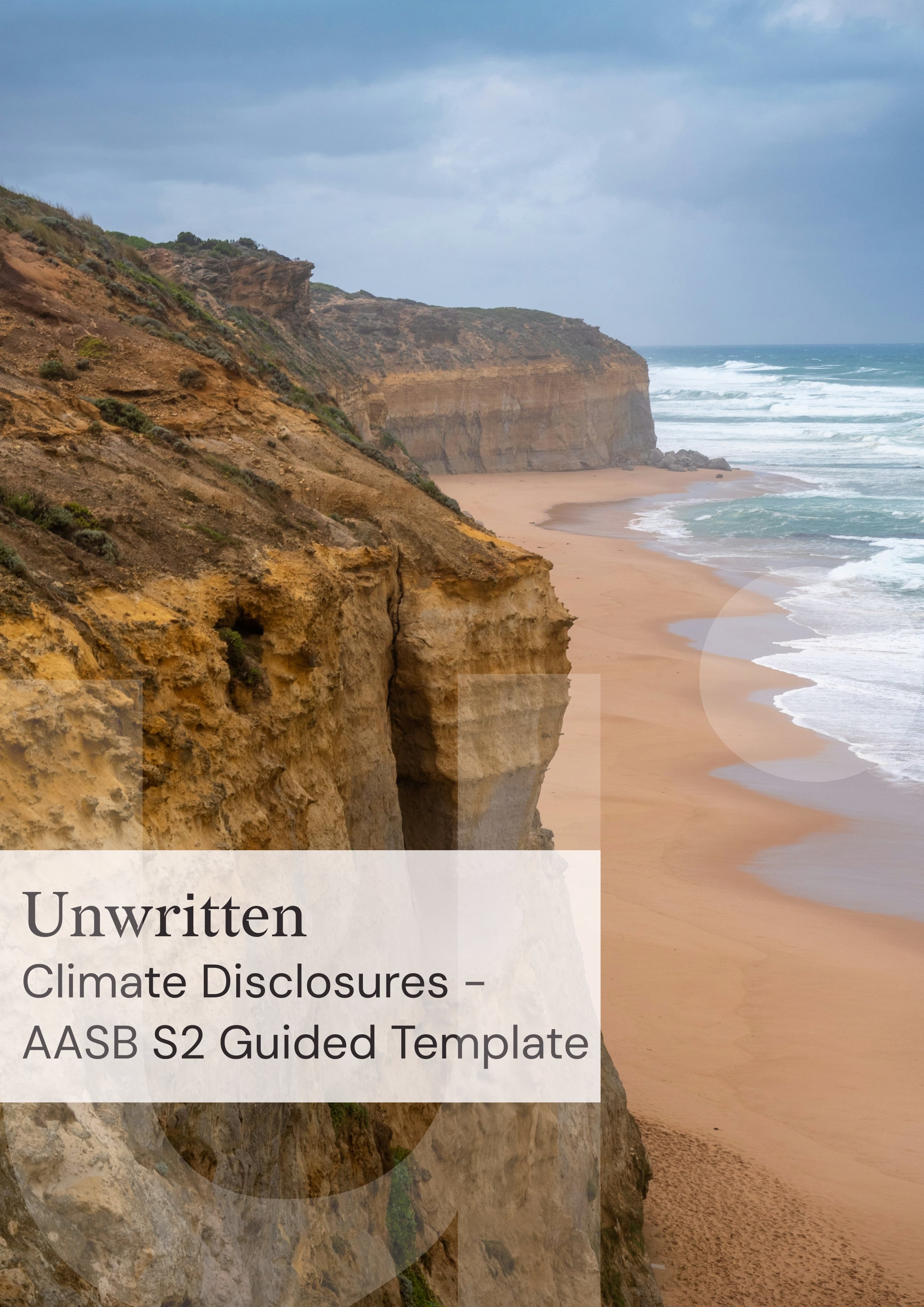Get started: Australia's AASB S2 climate disclosure rules
Get started: Australia's AASB S2 climate disclosure rules
Since the start of this year, the AASB S2 Standard has obliged the largest Australian businesses to disclose their exposure to climate-related financial risks. Specifically, the Standard asks entities to make public information about the climate-related risks and opportunities that could reasonably be expected to affect their cash flows, access to finance, or cost of capital.
Over the next 24 months the scope of the rules will expand to include a wider range of businesses in two stages, increasing the total number of disclosing entities from around 1,000 to around 3,500.
This short article summarises the most important aspects of the new rules, including all of the key implementation dates. It then links out to additional resources, including Unwritten's detailed open source template for preparing a compliant AASB S2 disclosure.
Overview
Under AASB S2, entities must provide a complete picture of climate-related risks to their operations. This includes information about governance, corporate strategy, and risk management practices. Some specific data and metrics are mandated too, including scenario analysis and greenhouse gas emissions across scopes 1, 2, and 3.
The disclosures are designed to be a core component of an entity's general purpose financial reporting, not a side show. Like all financial reporting, their purpose is to give investors clear and comparable information that can inform their operations. As such, the disclosures can be seen as an opportunity for businesses to turn climate risk into a strategic advantage — demonstrating to prospective investors that they manage systemic risks better than competitors.
“... the disclosures can be seen as an opportunity for businesses to turn climate risk into a strategic advantage — demonstrating to prospective investors that they manage systemic risks better than competitors.”
Key Dates
The rollout of AASB S2 is phased across three groups:
- Group 1 includes entities with consolidated revenues above AUD 500 million; with gross assets greater than $1 billion; or with 500 or more employees.
- Group 2 includes entities with consolidated revenues above AUD 200 million; with gross assets greater than $500 million; with 250 or more employees; or with assets under management of more than $5 billion.
- Group 3 includes entities with consolidated revenues above AUD 50 million; with gross assets greater than $25 million; or with 100 or more employees.
The key implementation dates map to these groups:
- 1 January 2025. First annual reporting period begins for Group 1 entities
- 1 July 2026. First annual reporting period begins for Group 2 entities.
- 1 July 2027. First annual reporting period begins for Group 3 entities.
Goals of the Regulation
There are three overarching objectives that the AASB S2 standard is intended to achieve:
- Ensure consistency with global standards. Climate risk disclosures are becoming a ubiquitous feature of capital markets around the world, especially as California's Senate Bill 261 comes into force in early 2026. AASB S2 ensures that Australian businesses meet the expectations of investors around the world.
- Encourage businesses to engage with the risks they face. Not all businesses face climate related risks. But for those that do have material concerns, the disclosure exercise is an opportunity to increase awareness of these within the business and to develop risk management strategies.
- Bolster the Australian economy. Australian businesses face a unique range of climate risks, from wildfires to loss of tourism and mining revenue. On the flipside, many will benefit from climate related opportunities, such as growing demand for transition metals. Climate disclosures give investors the information they need to allocate capital more effectively in light of these factors, reducing systemic risk and lowering the cost of capital in sectors with growth potential.
The Underlying Framework for AASB S2
AASB S2 is directly based on the global baseline set by the International Sustainability Standards Board (ISSB): IFRS S2 Climate-related Financial Disclosures. The ISSB's purpose, in turn, was to create a single, high-quality standard for climate reporting, which it did by fully incorporating and building on the recommendations of the Task Force on Climate-related Financial Disclosures (TCFD).
To summarise then: the TCFD's principles were absorbed into IFRS S2, which is now being adopted in Australia as AASB S2. The Australian Standard adopts IFRS S2 with minor modifications to facilitate its implementation in the wider Australian regulatory context.
Learn More
For more information and the latest updates, visit the Australian Accounting Standards Board Knowledge Hub for Climate-related Financial Disclosures.
Australia's AASB S2 climate disclosure rules
Australia's AASB S2 climate disclosure rules
For more guidance on getting started with disclosures, use this form to download Unwritten's open source AASB S2 template. The template is completely free and is based on our detailed knowledge of the regulation itself, as well as our analysis of disclosures from Australian firms in Group 1 and international firms subject to existing TCFD regimes such as those in the UK and Europe.


